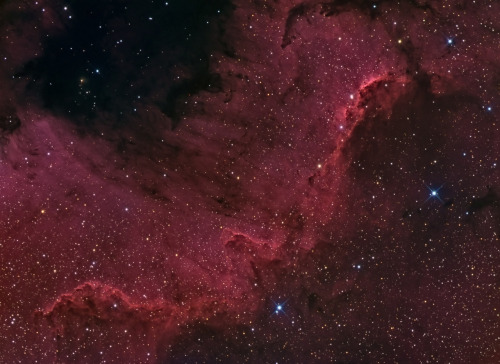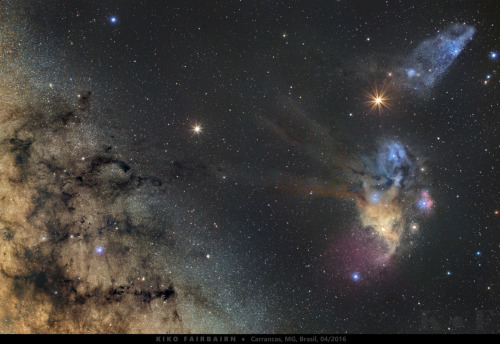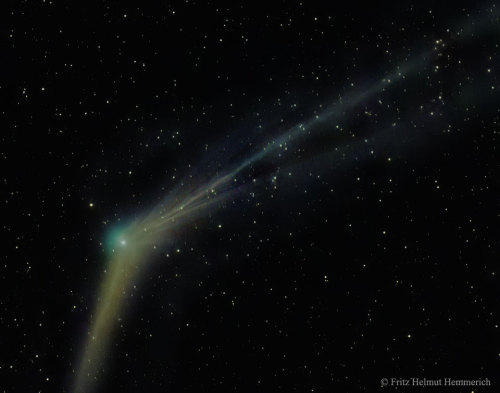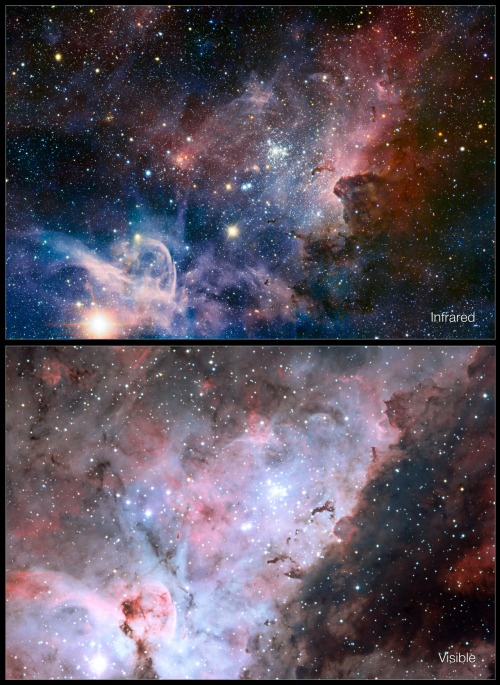GREETINGS FROM EARTH! Welcome to my space blog! Let's explore the stars together!!!
144 posts
Latest Posts by littlecadet-biguniverse - Page 2

The Soul Nebula.

The California Nebula.

Carina Nebula clouds. So stunning.


M8 - Lagoon Nebula Up Close
June is “Lagoon Month” from my latitude. The June and July New Moons will be dedicated to photographing this photogenic nebula. I have booked a camping trip in early June, so I should be able to start capturing some more photons then! :) Here’s my version with limited exposure time from 2013.

The Running Chicken Nebula.
Image Credit & Copyright: Andrew Campbell

Valles Marineris. “Grand Canyon” of Mars.
Image Credit: Viking Project, USGS, NASA

Our Moon along with Jupiter and it’s 4 largest moons.
Image Credit & Copyright: Cristian Fattinnanzi

Core of the Crab Nebula.
Image Credit: NASA, ESA - Acknowledgment: J. Hester (ASU), M. Weisskopf (NASA / MSFC)

Very colorful clouds of Rho Ophiuchi.
Image Credit & Copyright: Tom Masterson, ESO’s DSS

Herschel’s Eagle Nebula, some 6,500 light-years away.
Image Credit & Copyright: ESA/Herschel/PACS, SPIRE/Hi-GAL Project

Wings of a butterfly nebula.
Image Credit: Hubble Legacy Archive, NASA, ESA - Processing: Judy Schmidt

Orion Nebula And Horsehead Nebula

Galaxy Ngc474

The Sunflower Galaxy
What is the difference between a supernova and a hypernova?
That’s a really good question, and the simple answer is that a hypernova produces way more energy than a standard supernova. Supernovae are known as being bright explosions from massive stars, and their remnant is usually a neutron star.

Hypernovae, however, more commonly produce black holes due to being from stars more massive than those that cause supernovae. Often time, they appear brighter too, which is why an alternate name for hypernovae is “superluminous supernovae”. Hypernovae are sometimes also the cause of gamma-ray bursts, a dangerous release of energy so high that it will fry anything in its path.

Thanks for asking! :)


Centaurus A. Same object. Different wavelengths.
It’s scary to think most of our universe is invisible to us


Saturns north pole hexagon.
js

Enceladus, the sixth-largest moon of Saturn
js

Charon and Pluto: Strikingly Different Worlds
js

Gum 29 Star-Forming Region **follow viralography for more amazing photos**

New view of the Pillars of Creation - infrared
js

Southern NGC7000
js

Saturn and Mars visit Milky Way Star Clouds
js

Comet Catalina Emerges : Comet Catalina is ready for its close-up. The giant snowball from the outer Solar System, known formally as C/2013 US10 tails, making it an impressive object for binoculars and long-exposure cameras. The featured image was taken last week from the Canary Islands, off the northwest coast of Africa. Sky enthusiasts around the world will surely be tracking the comet over the next few months to see how it evolves. via NASA
js

Infrared/visible-light comparison of the Carina Nebula
js

The Milky Way was so very alive this weekend in the backcountry.. Hope you all had a chance to look up and watch the cosmos whiz by.. #stars #nightphotography #nightsky #darksky #adventure

Expedition 48 Crew Preparing to Return Home via NASA http://ift.tt/2bV7T75

Philae found!
Less than a month before the end of the mission, Rosetta’s high-resolution camera has revealed the Philae lander wedged into a dark crack on Comet 67P/Churyumov–Gerasimenko. The images were taken on 2 September by the OSIRIS narrow-angle camera as the orbiter came within 2.7 km of the surface and clearly show the main body of the lander, along with two of its three legs. The images also provide proof of Philae’s orientation, making it clear why establishing communications was so difficult following its landing on 12 November 2014. Philae was last seen when it first touched down at Agilkia, bounced and then flew for another two hours before ending up at a location later named Abydos, on the comet’s smaller lobe.After three days, Philae’s primary battery was exhausted and the lander went into hibernation, only to wake up again and communicate briefly with Rosetta in June and July 2015 as the comet came closer to the Sun and more power was available. The discovery comes less than a month before Rosetta descends to the comet’s surface. On 30 September, the orbiter will be sent on a final one-way mission to investigate the comet from close up, including the open pits in the Ma’at region, where it is hoped that critical observations will help to reveal secrets of the body’s interior structure.
Credit: ESA
